After two days of hippy life in Kabak, it was time to leave. The same taxi that had dropped us off came to pick us up, and we started to climb the hill in the rickety old minibus. Other people were waiting along the road, and we ended up with more people than seats, plus luggage. When we got to a steep part of the track, the bus simply couldn't manage it, and the driver had to ask two of the newcomers to get out and walk to the corner. The bus was dangerously overloaded, and I couldn't help wondering what would happen if we had a similar problem coming out of one of the many steep hairpin bends. Added to this, the driver spent most of the journey on the phone with one hand on the wheel, which did not exactly fill me with confidence.
Luckily, we made it to the top without further incident, loaded our car, and set off back down the cliff road. Our destination for the evening was Kekova, a protected area of coastline where a sunken city can be found. However, our route took us very close to the Saklıkent Canyon, so we thought we might as well drop by.
Upon arriving we realised we were hopelessly under-prepared, and that rather than the series of walkways I had imagined (similar to Plitvice Lakes), it would be more of a scramble and involve getting wet. Fortunately we had all our things with us, so managed to find a place to change. As we approached the gate, a man running a shoe hire shop stopped us and advised us that our flip-flops would be dangerous. I thought it was probably a sales technique, but as shoe hire was only 3tl thought we might as well. This turned out to be the right choice – navigating the canyon in flip-flops would have been very difficult and likely to end in injury.
The canyon is only accessible in the summer months, and getting to it involves crossing another river, which is still incredibly fast flowing. Ropes are set into the rocks on each side to help people cross, which was definitely necessary as the water came up to my waist. Once this barrier is crossed, it is possible to begin the walk up the gradually narrowing canyon. The walls rise steeply on both sides, shading the ground from the sun. A sign before the river crossing had warned us not to proceed without a guide, but as there was no evidence of anyone around to fill that role we proceeded alone.


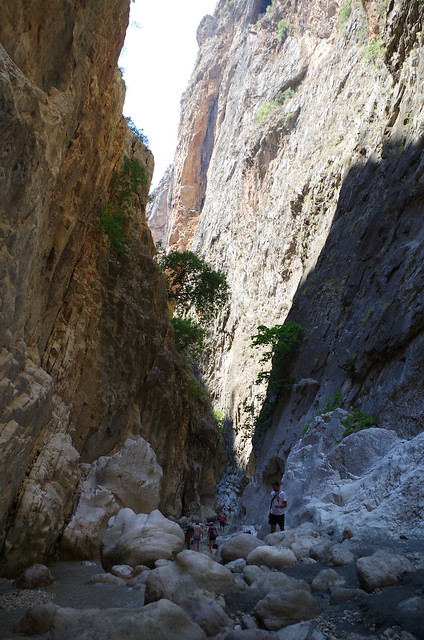
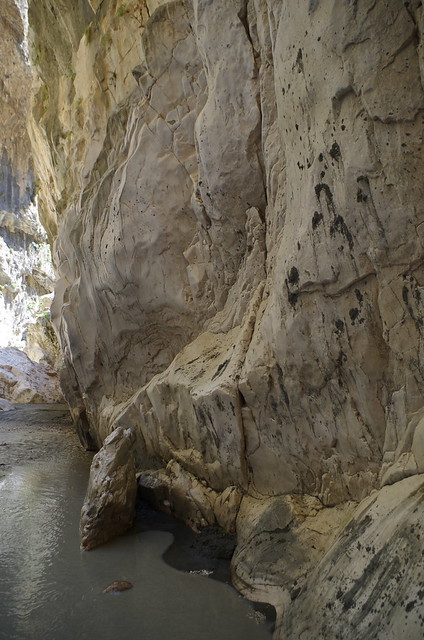
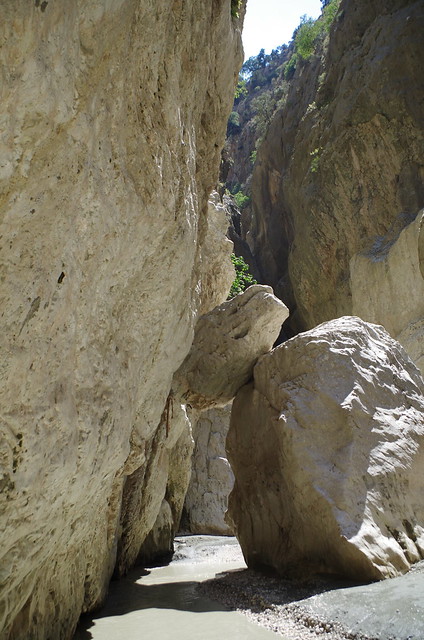
As we proceeded further, the route became more difficult. The water flowing through the canyon is grey with sediment, making it impossible to see where to put your feet. The river bed is rocky and the depth variable, and there were sections where we had to scramble up and down boulders through fast flowing water in order to continue. After about an hour, we came to a very difficult section where the water was chest height. I decided to let the boys go on whilst I held the camera, and ended up chatting to another English lady who had also sent her family onward. The boys returned after half an hour to say that it would have been impossible alone, and that they had needed to push and pull each other over the high and slippery boulders to make progress.
The way back was trickier to traverse, as I think it is always easier to climb up than down. However, by this stage I was getting the hang of it, and we actually took less time to get back than it had taken us to go. The canyon was definitely not what I had imagined. I had thought it would be platform walkways, with the odd token wading section, hard hats and guides. Turns out in reality you just pay your entrance fee and go nuts, which was far, far more fun.
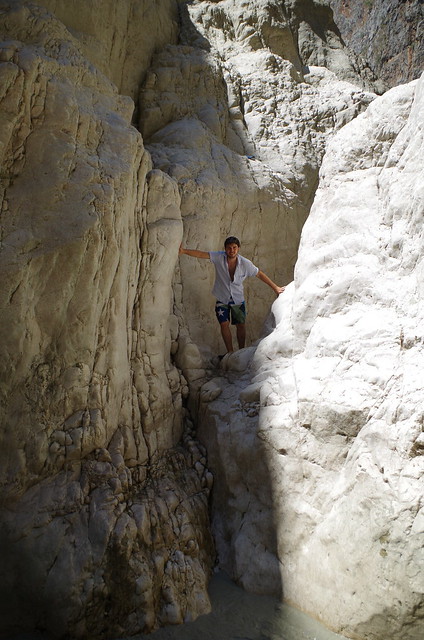
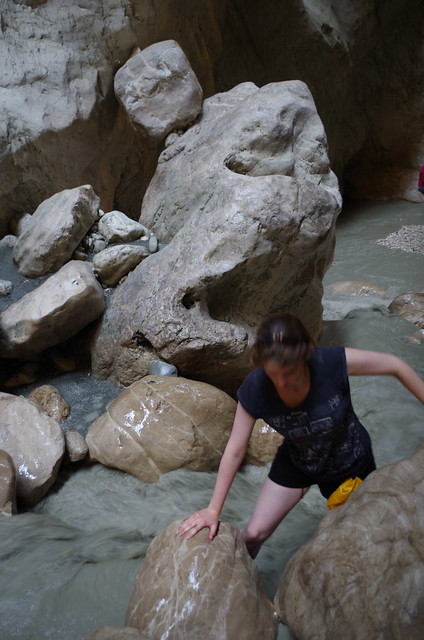
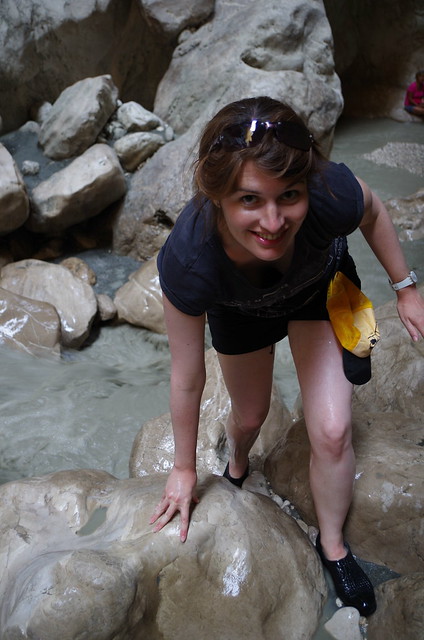
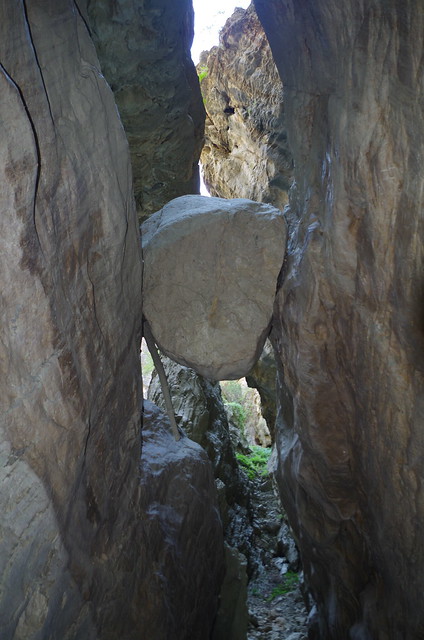
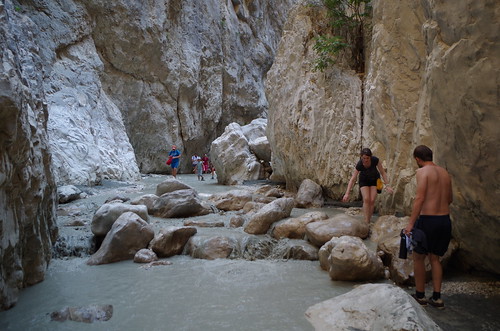
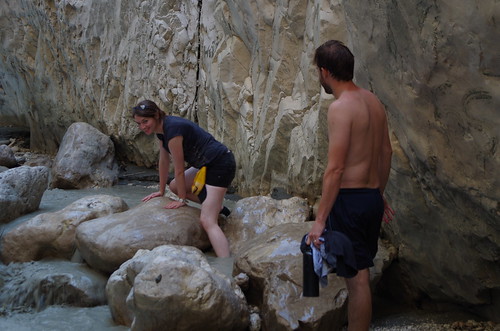
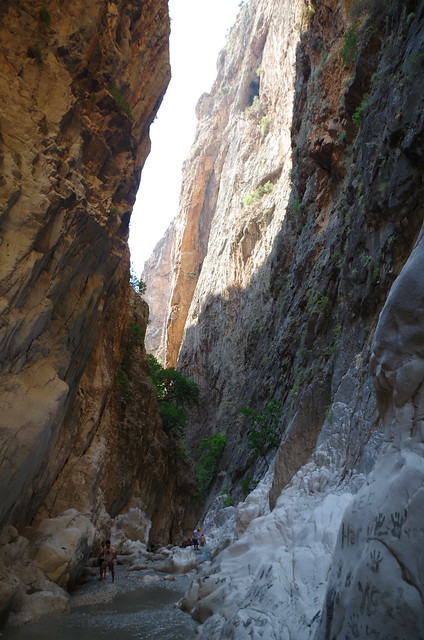
Tired and happy, we clambered back into the car and continued the drive to Kekova. Oli bargained down the price for two rooms plus breakfast, and the owner said he would sort us out with a boat tour to the sunken city in the morning. We ate surprisingly excellent food on the harbour front, and retired to our rooms to get a good nights sleep.
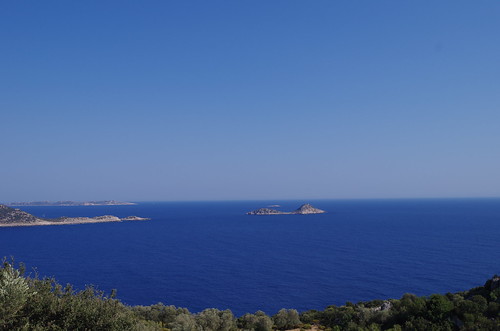
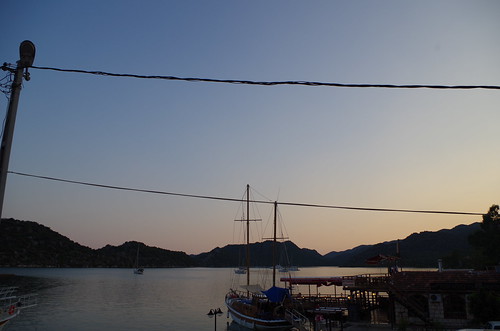
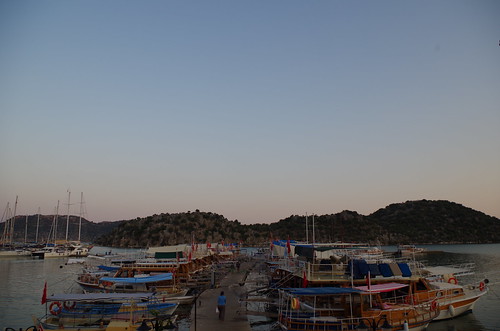
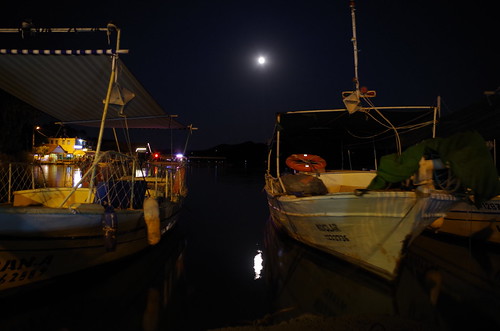
Despite being eaten alive by mosquitoes, we had all slept quite well. Breakfast was delicious, and we headed down to the harbour to begin our boat tour. We set out on a tiny fishing boat, and were the only passengers. Due to its protected status, the Kekova bay area is immaculate and mostly undeveloped. The boat took us past the village of Kale where we could see the old castle perched on the hill, and continued on to the main area of the ruins.
From a distance, the remains of the ancient Lycian/Byzantine city simply looked like rocks on the hillside, but as we got closer, the remains of buildings and doorways became apparent. Stairways descended into the water, and the ghostly remnants of the walls and foundations of buildings were visible below the surface. It was an incredibly beautiful and interesting sight. Swimming and diving are banned in the main area of the ruins, but are permitted in the site of the old shipyard. We moored the boat here and went for a dip in the clear water. I wished we had a snorkel; I could see old walls lying tantalisingly below the surface and was dying to get a closer look.
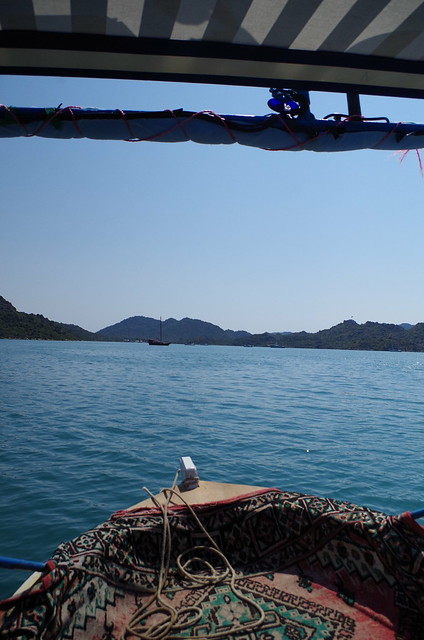
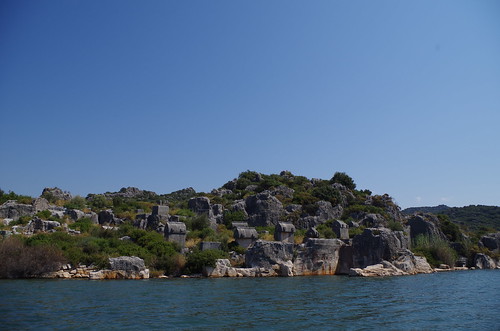


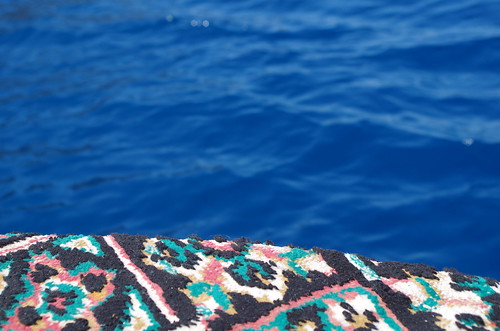
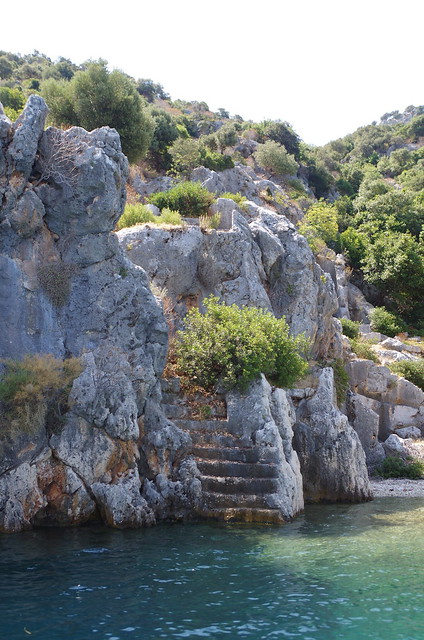
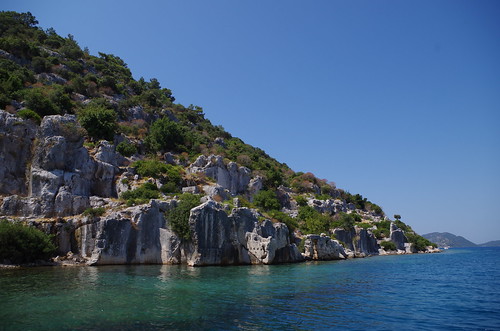
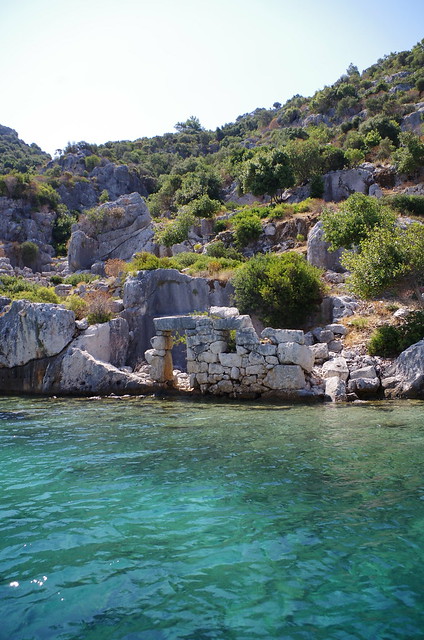
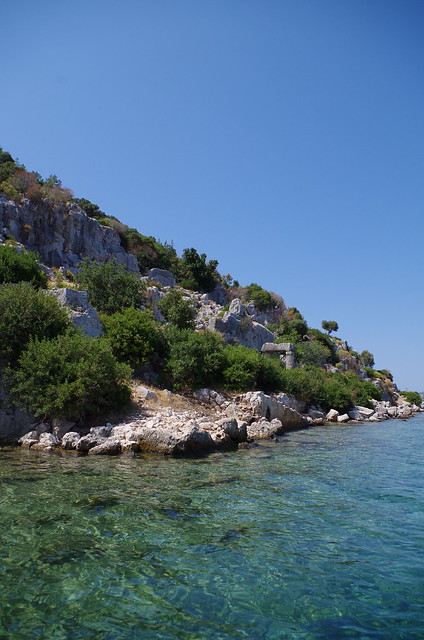
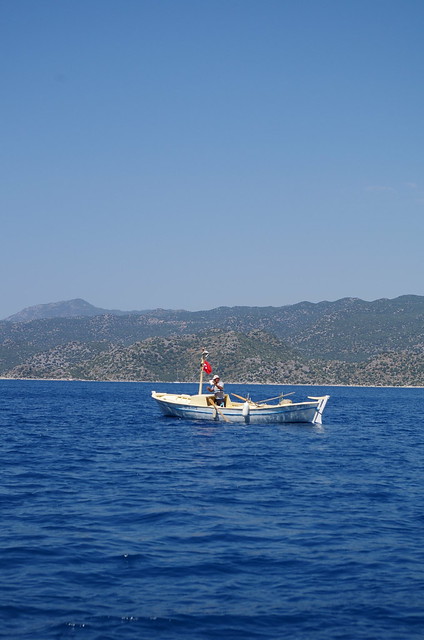
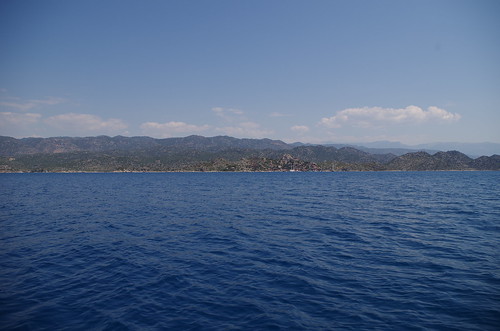

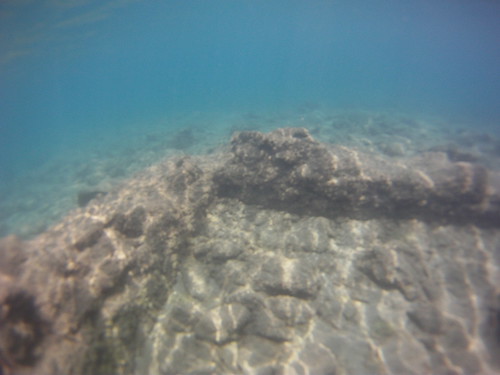


All too soon, we were back on the boat and heading back to the village. We had a long drive ahead of us to get to Denizli, but the scenery was stunning. The road took us through rocky, forested mountains. It was an incredibly wild landscape and seemed to stretch for miles. We arrived in Denizli in the early evening, and spent a quiet evening in.
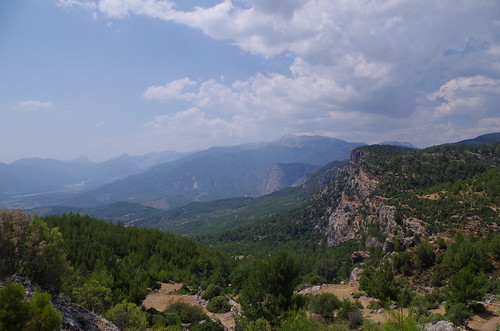
The next day we headed to the Pammukale (literally translates as Cotton Castle) to see the travertines. It is a huge natural structure, set on a hill and formed by carbonate materials and flowing water. They are snow white, but a few years ago were in danger of losing their colour due to local hotels using the water. Fortunately this has been halted, and they are still beautiful.
It is forbidden to wear shoes on the travertines, so we proceeded up the hill barefoot. It was surprisingly easy to negotiate, and the surface is actually very grippy. We were all grateful that we had decided to visit in the late afternoon, as with the more intense sun the white surface would have been blinding. At some points the mineral surface almost looks like snow, and the blue sky set it off beautifully.
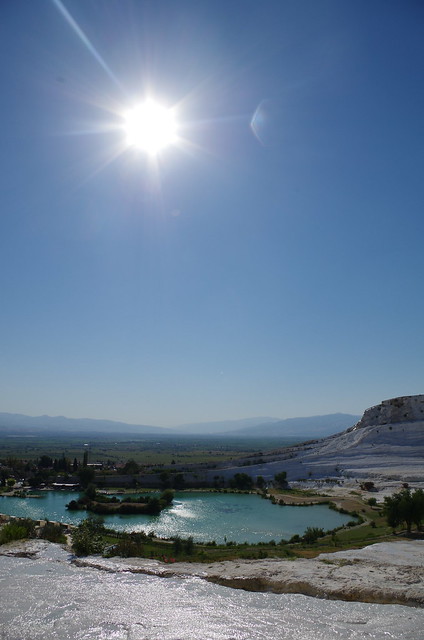
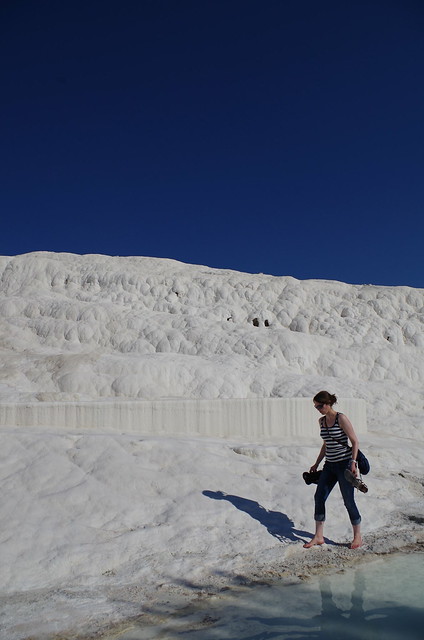
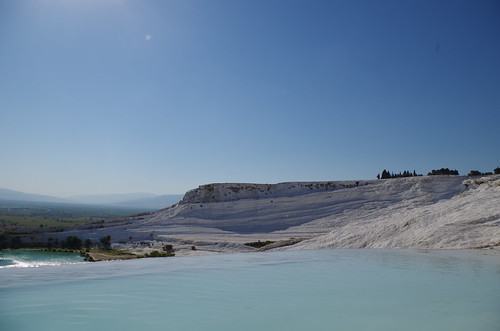
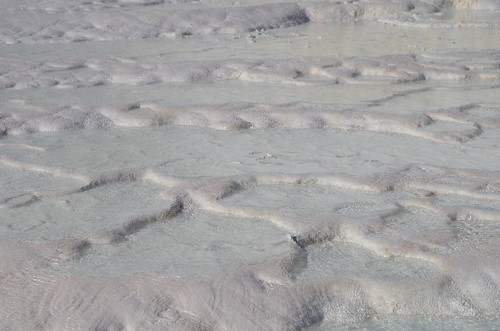
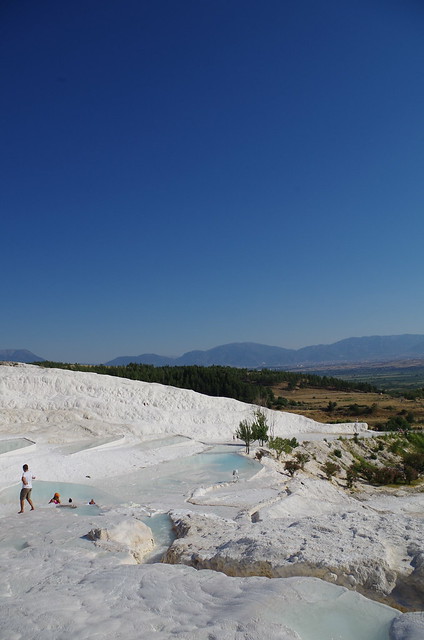
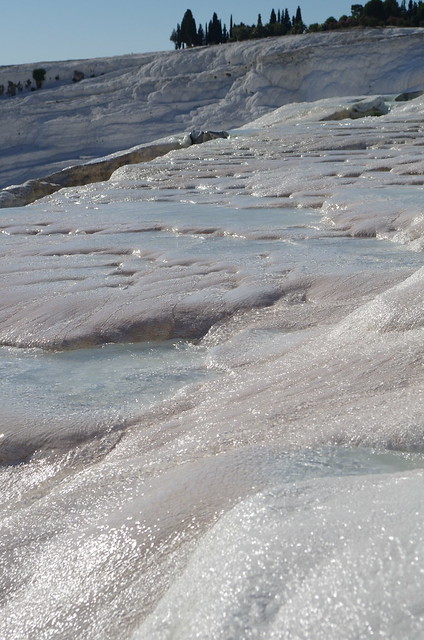

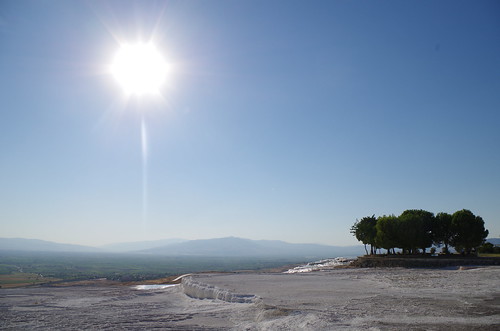
At the top of the travertines sits the ancient Greco-Roman and Byzantine city of Hierapolis, covering a huge expanse. The city has the most incredible views over the valley and to the mountains beyond. Many of the ruins are still fairly intact, looking regal in the early evening sun. Large lizards skittered over the rocks, and were so well camouflaged that they were almost impossible to spot when not moving.
As we began to descend the travertines the sun was starting to set, giving them a wholly different character. The white rock glowed in the sun, and the lower light cast shadows to show off the textured surface. It was so beautiful I almost didn't want to leave it behind, but sadly we had to.
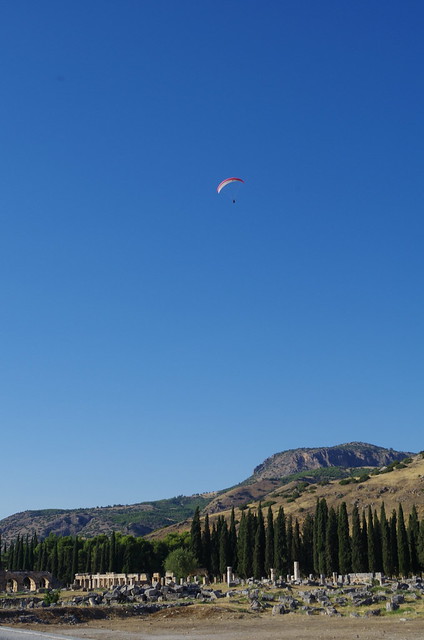

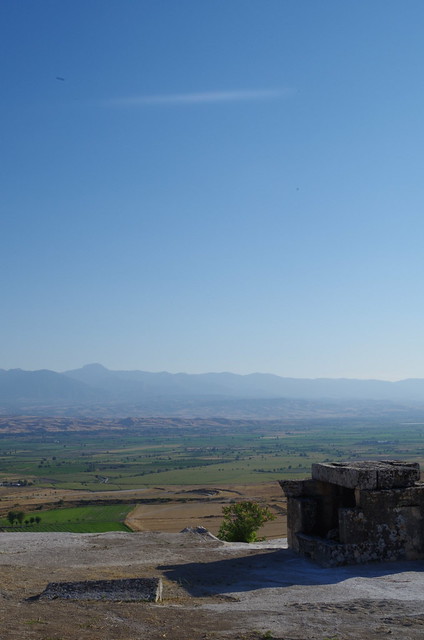
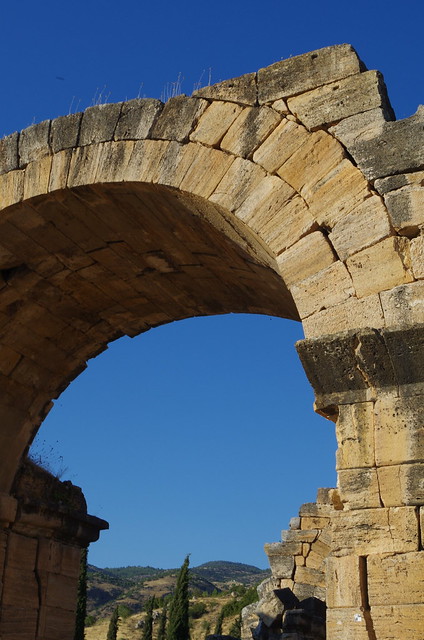
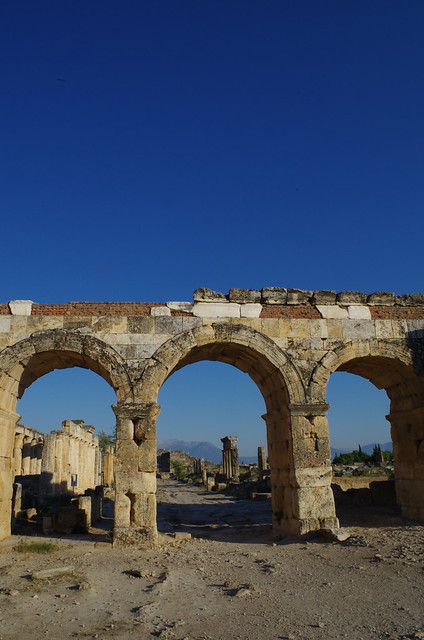
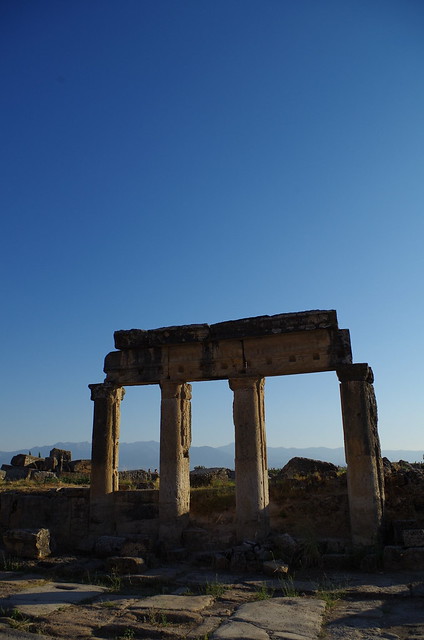
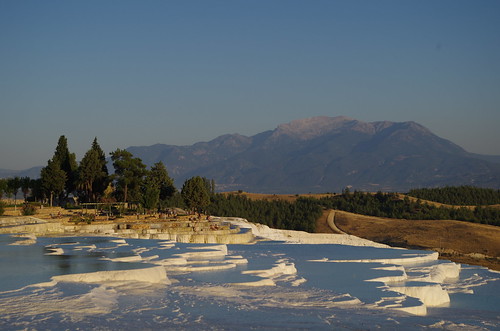
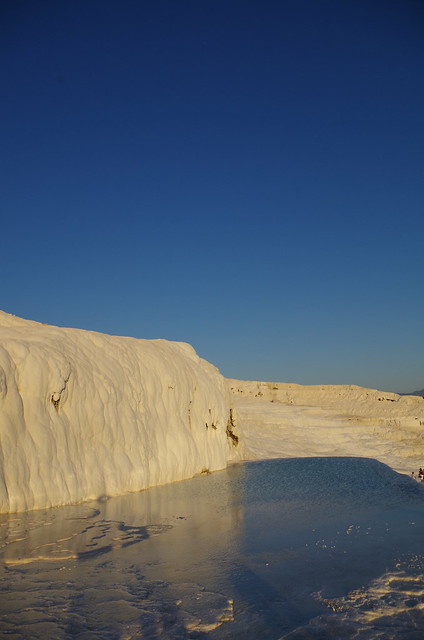
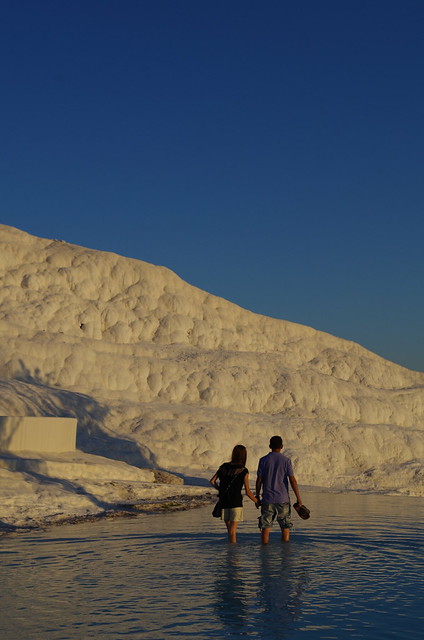
Today we leave Denizli and head to Akbük for the weekend, where hopefully we will be joined by Oli's parents. We have just under four weeks until we leave İzmir, and a lot to do in that time!
Luckily, we made it to the top without further incident, loaded our car, and set off back down the cliff road. Our destination for the evening was Kekova, a protected area of coastline where a sunken city can be found. However, our route took us very close to the Saklıkent Canyon, so we thought we might as well drop by.
Upon arriving we realised we were hopelessly under-prepared, and that rather than the series of walkways I had imagined (similar to Plitvice Lakes), it would be more of a scramble and involve getting wet. Fortunately we had all our things with us, so managed to find a place to change. As we approached the gate, a man running a shoe hire shop stopped us and advised us that our flip-flops would be dangerous. I thought it was probably a sales technique, but as shoe hire was only 3tl thought we might as well. This turned out to be the right choice – navigating the canyon in flip-flops would have been very difficult and likely to end in injury.
The canyon is only accessible in the summer months, and getting to it involves crossing another river, which is still incredibly fast flowing. Ropes are set into the rocks on each side to help people cross, which was definitely necessary as the water came up to my waist. Once this barrier is crossed, it is possible to begin the walk up the gradually narrowing canyon. The walls rise steeply on both sides, shading the ground from the sun. A sign before the river crossing had warned us not to proceed without a guide, but as there was no evidence of anyone around to fill that role we proceeded alone.





As we proceeded further, the route became more difficult. The water flowing through the canyon is grey with sediment, making it impossible to see where to put your feet. The river bed is rocky and the depth variable, and there were sections where we had to scramble up and down boulders through fast flowing water in order to continue. After about an hour, we came to a very difficult section where the water was chest height. I decided to let the boys go on whilst I held the camera, and ended up chatting to another English lady who had also sent her family onward. The boys returned after half an hour to say that it would have been impossible alone, and that they had needed to push and pull each other over the high and slippery boulders to make progress.
The way back was trickier to traverse, as I think it is always easier to climb up than down. However, by this stage I was getting the hang of it, and we actually took less time to get back than it had taken us to go. The canyon was definitely not what I had imagined. I had thought it would be platform walkways, with the odd token wading section, hard hats and guides. Turns out in reality you just pay your entrance fee and go nuts, which was far, far more fun.







Tired and happy, we clambered back into the car and continued the drive to Kekova. Oli bargained down the price for two rooms plus breakfast, and the owner said he would sort us out with a boat tour to the sunken city in the morning. We ate surprisingly excellent food on the harbour front, and retired to our rooms to get a good nights sleep.




Despite being eaten alive by mosquitoes, we had all slept quite well. Breakfast was delicious, and we headed down to the harbour to begin our boat tour. We set out on a tiny fishing boat, and were the only passengers. Due to its protected status, the Kekova bay area is immaculate and mostly undeveloped. The boat took us past the village of Kale where we could see the old castle perched on the hill, and continued on to the main area of the ruins.
From a distance, the remains of the ancient Lycian/Byzantine city simply looked like rocks on the hillside, but as we got closer, the remains of buildings and doorways became apparent. Stairways descended into the water, and the ghostly remnants of the walls and foundations of buildings were visible below the surface. It was an incredibly beautiful and interesting sight. Swimming and diving are banned in the main area of the ruins, but are permitted in the site of the old shipyard. We moored the boat here and went for a dip in the clear water. I wished we had a snorkel; I could see old walls lying tantalisingly below the surface and was dying to get a closer look.















All too soon, we were back on the boat and heading back to the village. We had a long drive ahead of us to get to Denizli, but the scenery was stunning. The road took us through rocky, forested mountains. It was an incredibly wild landscape and seemed to stretch for miles. We arrived in Denizli in the early evening, and spent a quiet evening in.

The next day we headed to the Pammukale (literally translates as Cotton Castle) to see the travertines. It is a huge natural structure, set on a hill and formed by carbonate materials and flowing water. They are snow white, but a few years ago were in danger of losing their colour due to local hotels using the water. Fortunately this has been halted, and they are still beautiful.
It is forbidden to wear shoes on the travertines, so we proceeded up the hill barefoot. It was surprisingly easy to negotiate, and the surface is actually very grippy. We were all grateful that we had decided to visit in the late afternoon, as with the more intense sun the white surface would have been blinding. At some points the mineral surface almost looks like snow, and the blue sky set it off beautifully.








At the top of the travertines sits the ancient Greco-Roman and Byzantine city of Hierapolis, covering a huge expanse. The city has the most incredible views over the valley and to the mountains beyond. Many of the ruins are still fairly intact, looking regal in the early evening sun. Large lizards skittered over the rocks, and were so well camouflaged that they were almost impossible to spot when not moving.
As we began to descend the travertines the sun was starting to set, giving them a wholly different character. The white rock glowed in the sun, and the lower light cast shadows to show off the textured surface. It was so beautiful I almost didn't want to leave it behind, but sadly we had to.









Today we leave Denizli and head to Akbük for the weekend, where hopefully we will be joined by Oli's parents. We have just under four weeks until we leave İzmir, and a lot to do in that time!
No comments:
Post a Comment